![]()
![]()
![]()
Use LEFT and RIGHT arrow keys to navigate between flashcards;
Use UP and DOWN arrow keys to flip the card;
H to show hint;
A reads text to speech;
19 Cards in this Set
- Front
- Back
|
What's a major reason to why some species are very similar? |
Shared history: A certain feature/trait evelved in a common ancestor and is largely unchanged in all descendants |
|
|
How can we explain that some related species are similar but their ancestor was different? |

Then there has been shared environment, i.e. shared selection pressure. The change in descendants occurs in response to similar enirvonments => they converge onto similar forms (independantly - it can happen att different times - indicated by the stars in pic), there can be more than one way (diff mutations) to get a preferable form |
|
|
Why do some features keep appearing in distantly related groups? Give an example! |
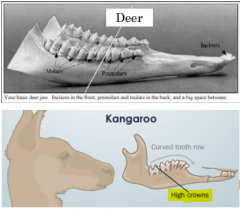
CONVERGENT EVOLUTION: common selection pressure can lead to common appearance (in some or many features). These are often not very dramatic changes. Example: the grass eating herbivores kangaroo and deer. Since they have the same diet, they have developed similar thooth and jaw features even though they are not very closely related. In contrast, the kangaroo's more close relative wallaby has different theeth and jaw structure since they have a diff diet (divergent evolution) |
|
|
What can cause divergent evolution? |
Stocastic factors or environmental differences |
|
|
What is meant with convergence per definition? Give an example. |

Reaching the same functional solution via different pathways (can be the same genes but diff mutations, in the same gene family or totally diff genes involved). E.g. Vertebrate and cephalopod eyes, camera-type eye with the same structures/components but the arrangement of these are different so the fundamental differece is regarding the nervecells but the eye's function is the same. In this case the genes for the lens in both of the eyes involve genes from the same gene family. |
|
|
What is parallellism? Give an example. |
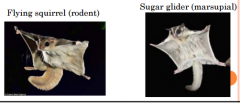
Reaching the same functional solution via the same pathway, but independantly (note that 'same pathway' is maybe not entirely true, there might be small differences at molecular level but in a broader sense, yes it's the same pathway). Usually occurs in close relatives, which makes it harder to detect. E.g. Flying squirrel (rodent) and Sugar glider (marsupial) have both developed skin-flaps between their front- and backlegs which enables them to glide in the air. |
|
|
What is reversal evolution? Give an example and give possible explanations to why it has happened. |
Reversing a previous change, so as to resemble an ancestral feature. E.g. loss of insect wings is estimated to have occured thousands of times in almost every order. Highest rates of wing loss seem to be in alpine areas and on islands. This might be because dispersal on islands is not helpful, in alpine areas it might be to high energy requirment to maintain flight. |
|
|
What is mimicry? What is needed for mimicry to work? |
A particular kind of convergence: to a similar appearance in order to decieve other organisms. This is not a functional problem, but a problem with predators that causes the convergence. Sympatry is needed for this to work, the organisms need to be in the same place (overlap in range). |
|
|
What is Batesian mimicry? Why use this? |

A species witout defence (e.g. An edible sp.) mimics one with defence. This is better for the defenceless species, worse for the defended sp since predators might encounter the edible at times, so it takes longer time for them to learn avoiding harmful sp (when predators 'test' the defence). The cost for mimicing is probably cheaper than having a defence. |
|
|
Batesian mimicry: how does predators learn about a harmful prey item, if getting bitten gets it killed? |
Possible explanations: 1. The prey might be able to control the amount of toxin delivered in it's bite e.g snake 2. The prey might vary in toxicity, so that not all prey items might be fatal, just really unpleasant (promotes learning the avoidence) e.g monarch butterflies feed on milkweed to derive toxins - they accumulate diff amounts 3. Evolution of instinctive avoidence of certain patterns in the predator, so that naive predators still avoid the prey (fixation of genetic components), e.g avoid all banded snakes |
|
|
What's Muellerian mimicry? |
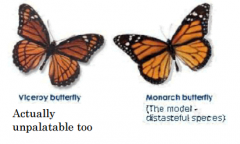
Both species have defences (that might differ) and mimic one another, "sharing their defence". Both species benefit because the predator encounters harmful prey more frequently and learns to avoid all of them. |
|
|
What is paedomorhposis? Name two examples. |
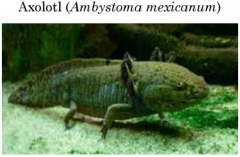
Retention of some juvenile or larval traits into maturity/reproductive state. Might be thought of as another kind of reversal. E.g. Axolotls, they keep their juvenile fin & gills as sexually mature individuals. Birds might have evolved through paedomorphosis. mature birds snout and eyes resemle those of juvenile crocs & archosaurs. |
|
|
Can plants be paedomorph? |
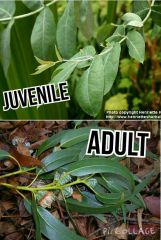
Yes, for e.g. Eucalyptus has usually opposite foliage as a juvenile and alternaty arranged as adult (see pic). In E. cinera there's no shift in the leaf arrangement of adults. |
|
|
HOW can paedomorhposis occur? |
Turn off a gene pathway that would otherwise give rise to some adult features. This might be easy if one gene was involved, the occurance was independant. A hypothesis that a small change = large effect has been supported by experiments on Axolotl, a change in one gene seems to be the cause of paedomorphosis (the recessive/dominant met/MET gene, the recessive met gives paedomorphy when homozygous). |
|
|
WHY have paedomorphosis? |
Reversal to pre-existing state that works can be a safe way to avoid a new variable environment (e.g. land) by returning to a former stable environment (e.g. a lake), can be to avoid competition. |
|
|
How can the paedomorhpy be kept in Axolotl, regarding how it occurs?
|
It's considered difficult to fix an advantageous recessive allele, but in salamanders this can be done since the paedomorphs (homozyg: met/met) must stay in water and therefore rarely breeds with metamorphosing individuals (since these only return to water briefly each year) - different breeding behavior.
|
|
|
Could the met gene in Axolotl be considered a speciation gene? Motivate. |
It might be so that it leads to instant speciation, the different breeding behavior caused by the met gene can be seen as a trigger. If the met gene is a speciation gene, then the fixation and persistance is explained via speciation and the met gene can somewhat be considered as a speciation gene since it hinders gene flow, at least in one direction. |
|
|
What are the two hypotheses of underlying reason for the Pheidole ant's occupation in similar niches on different continents? |
1. Phylogenetic niche conservation and long-distance dispersal (LDD). Colonisation of niches they're already adapted for - finds the niche by dispersal. Evolution not deterministic. History is more important to determine biogeography pattern. 2. Niche shifting, no (or few) long-distance dispersal = deterministic evolution. If the same conditions => the same outcome, irrespective of history. |
|
|
What did the researchers find in their study of the Pheidole ants (results)? |

The radiations into each continent largely independent, only one shift from New World to Old World (one LDD), but there was a lot of niche shifting. Niches occupied in the two (Old/New world) mirror each other and there's a similar degree of species richness: primarily deterministic evolution, not so limited by historical factors, i.e. pattern is repeated when given the opportunity. |

